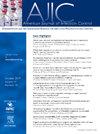How do residential aged care antibiograms compare with other local resistance data?
IF 3.8
3区 医学
Q2 INFECTIOUS DISEASES
引用次数: 0
Abstract
Background
Antibiograms can optimize empirical antibiotic prescribing; however, they are not readily available for residential aged care facilities (RACFs) in Queensland, Australia. This study aimed to determine whether alternatively available data can be used to approximate resistance patterns for RACFs.
Methods
Annual RACF-specific antibiograms were compared with local hospital antibiograms accessed through pathology providers. Additionally, composite antibiograms, of geographically united RACF data, were compared with regional hospital and private pathology RACF antibiograms. Antibiotic susceptibility rates for commonly observed bacteria (Escherichia coli, Klebsiella pneumonia, Enterococcus faecalis, Pseudomonas aeruginosa, and Staphylococcus aureus) were compared among different antibiograms using Fisher exact test, with a P value ≤ 0.05 indicating the statistically significant difference. The concordance among the antibiograms was described by percentage similarity overall and for a subset of clinically relevant pathogen-antibiotic pairs.
Results
Composite RACF antibiogram was highly concordant (83%-100% similarity) to private pathology RACF data when compared for clinically relevant pathogen-antibiotic pairs. Mixed results were found when individual RACF-specific antibiograms were compared with local hospital all-ages and ≥ 65 years data (50%-100% and 67%-100% similarity, respectively).
Conclusions
Private pathology RACF antibiograms can serve as a proxy indicator of resistance patterns for RACFs. Mixed findings were noted for comparisons with hospital data.
如何比较住院老年护理抗生素图与其他地方耐药数据?
背景:抗生素图可以优化经验性抗生素处方,但它们并不容易用于澳大利亚昆士兰州的住宅老年护理设施(racf)。这项研究的目的是确定是否可以使用其他可用的数据来近似racf的抗性模式。方法:对通过病理提供人员获得的当地医院年度racf特异性抗生素图进行比较。此外,将地理上统一的RACF数据的复合抗生素图与地区医院和私人病理RACF抗生素图进行比较。采用Fisher精确检验比较不同抗生素谱间常见细菌(大肠杆菌、肺炎克雷伯菌、粪肠球菌、铜绿假单胞菌和金黄色葡萄球菌)的药敏率,p值≤0.05为差异有统计学意义。抗生素图之间的一致性用总体相似度百分比来描述,并且用于临床相关病原体-抗生素对(pap)的子集。结果:与临床相关pap相比,复合RACF-抗生素图与私人病理RACF数据高度一致(83-100%相似)。当将个体racf特异性抗生素图与当地医院全年龄和≥65岁的数据进行比较时,发现混合结果(分别为50-100%和67-100%相似)。结论:私人病理RACF抗生素谱可作为RACF耐药模式的替代指标。在与医院数据进行比较时,注意到不同的发现。
本文章由计算机程序翻译,如有差异,请以英文原文为准。
求助全文
约1分钟内获得全文
求助全文
来源期刊
CiteScore
7.40
自引率
4.10%
发文量
479
审稿时长
24 days
期刊介绍:
AJIC covers key topics and issues in infection control and epidemiology. Infection control professionals, including physicians, nurses, and epidemiologists, rely on AJIC for peer-reviewed articles covering clinical topics as well as original research. As the official publication of the Association for Professionals in Infection Control and Epidemiology (APIC)

 求助内容:
求助内容: 应助结果提醒方式:
应助结果提醒方式:


